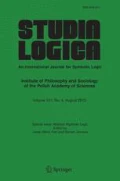Abstract
THINKER is an automated natural deduction first-order theorem proving program. This paper reports on how it was adapted so as to prove theorems in modal logic. The method employed is an “indirect semantic method”, obtained by considering the semantic conditions involved in being a valid argument in these modal logics. The method is extended from propositional modal logic to predicate modal logic, and issues concerning the domain of quantification and “existence in a world's domain” are discussed. Finally, we look at the very interesting issues involved with adding identity to the theorem prover in the realm of modal predicate logic. Various alternatives are discussed.
Similar content being viewed by others
References
B. Chellas,Modal Logic, Cambridge University Press, 1980.
P. Jackson endH. Reichgelt,A general proof method for first order modal logic,IJCAI-10, 1987, pp. 942 – 944.
D. Kalish andR. Montague,Logic Hartcourt, Brace, Janovich, 1964.
D. Kalish, R. Montague andG. Mar,Logic, Hartcourt, Brace, Janovich, 1980.
S. Kripke,Identity and necessity, in M. Munitz, ed.,Identity and Individuation, New York University Press, 1971, pp. 135 – 164.
S. Kripke,Naming and necessity, in D. Davidson and G. Harman, eds,Semantics of Natural Language, D. Reidel Publ. Co., Dordrecht 1972, pp. 253–355 and 763 – 769.
M. McRobbie, R. Meyer andP. Thistlewaite,Towards efficient ‘knowledge-based’ automated theorem proving for non-standard logics,CADE-9, Springer-Verlag 1988, pp. 197 – 217.
C. Morgan,Methods for automated theorem proving in non-classical logics,IEEE Trans. on Computers, 1976, pp. 852 – 862.
C. Morgan,Autologic,Logique et Analyse, 1985, pp. 257 – 282.
H. Ohlbach,A resolution calculus for modal logics,CADE-9, Springer-Verlag 1988, pp. 500 – 516.
F. J. Pelletier,Completely Non-Causal, Completely Heuristic-Driven, Automatic theorem Proving Tech. Report TR82-7, Dept. Computing Science, Univ. Alberta, 1982.
F. J. Pelletier,Further Developments in THINKER, an Automated Theorem Prover Tech. Report TR-ARP-16/87 Automated Reasoning Project, Australia National University, 1987.
F. J. Pelletier,The philosophy of automated theorem proving,Proceedings of IJCAI-91, 1991.
R. Smullyan,First Order Logic, Springer-Verlag 1968.
P. Thistlewaite, M. McRobbie andR. Meyer,Automated Theorem Proving in Non-Classical Logics, Pitman, 1987.
P. Thistlewaite, R. Meyer andM. McRobbie,Advanced theorem proving techniques for relevant logics,Logique et Analyse, 1985, pp. 233 – 258.
A. Whitehead andB. Russell,Principia Mathematica, Cambridge University Press 1910.
G. Wrightson,Non-classical logic theorem proving,Journal of Automated Reasoning, 1985, pp. 35 – 37.
Author information
Authors and Affiliations
Rights and permissions
About this article
Cite this article
Pelletier, F.J. Identity in modal logic theorem proving. Stud Logica 52, 291–308 (1993). https://doi.org/10.1007/BF01058393
Received:
Issue Date:
DOI: https://doi.org/10.1007/BF01058393




